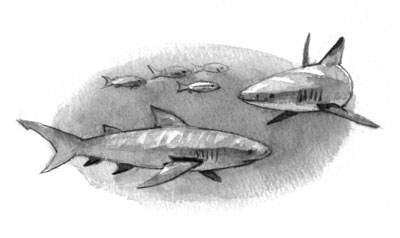Swimming with Sharks

For the preparation to illustrate this children's book, as the illustrator, I received lots of materials about sharks from the author, Twig and the editor, Amy. I have studied the lives of may different kinds of sharks: Angel Sharks, Basking Sharks, Blacktip Reef Sharks, Blue Sharks, Dogfish, Great White Sharks, Hammerhead Sharks, Mako Sharks, Nurse Sharks, Sandbar Sharks, Sandtiger Sharks, Six-gill Sawshark, Seven-gill Shark, Tiger Shark, Whale Sharks, White-Tip Reef Sharks, Wobbegong Sharks, Zebra Sharks.
Just like most people, I was afraid of sharks, or I should say, hated sharks, and because I knew very little about sharks. But after the study and reading Twig's story, I understood much better about sharks. As an important part of the nature, we can learn much from studying the sharks.
Brief Descriptions of Sharks:
ANGEL SHARK:
- Angel shark has flat body like a stingray -- you can tell the shark is not a ray because the pectoral fins are not attached to the head.
- They bury themselves in the sand or mud with only the eyes and part of the top of the body exposed.
- Angel sharks are bottom feeders, eating crustaceans like clams and mollusks and fish that are swimming close to the ocean floor
BASKING SHARK:
- Basking shark is the second largest shark (about 30 feet long and 8,000 pounds)
- Filters plankton from the water using "gill rakers"
BLACKTIP REEF SHARK:
- Blacktip Reef Shark does well in captivity so is often found in aquariums (which is why we have so many photos of it)
- About 6 feet long.
- Grey with a black tip on its fins and white streak on its side
BLUE SHARK:
- A blue shark is about 12 feet long.
- Sleek, tapered body
- Blue sharks are among the fastest swimming sharks and can even leap out of the water
- Diet consists mostly of squid, but it will eat almost anything
- Blue shark is considered dangerous - have attacked people
BULL SHARK:
- Bull shark is third most dangerous to people
- Can swim in salt and fresh water and have even been found in the Mississipi river.
COOKIECUTTER SHARK:
- Cookiecutter shark is a small shark (less than 2 feet long)
- Cookiecutter shark eats perfecty round chunks out of living whales and dolphins by clamping its teeth extremely sharp teeth onto them.
GOBLIN SHARK
- Goblin shark is very uncommon and likely the strangest looking shark (rarely seen)
- pale, pinkish grey skin with a long pointed snout (it looks a bit like a sword on top of its head)
- Goblin shark lives in very deep water.
- found off the coast of Japan in 1898... until that time it was believed to have been extinct for 100 million years
GREAT WHITE SHARK:
- Great white shark found more attacks on people than any other type.
- A great white shark is averages 12 feet long and 3,000 pounds.
- unlike most sharks, Great White Shark can lift its head out of the water.
HAMMERHEAD SHARK:
- Hammerhead sharks unlikely to attack people, but considered dangerous due to its predatory nature and its size
- eyes and nostrils are far apart, giving it a "hammerhead" appearance and allowing the shark to extend the range of its senses.
MAKO SHARK:
- Mako shark is the fastest swimmer (43 miles per hour)
- known to leap out of the water (sometimes into boats)
NURSE SHARK:
- Nurse shark is bottom dwelling shark
- thin, fleshy, whisker-like organs on the lower jaw in front of the nostrils that they use to touch and taste
- hunt at night, sleep by day
- You can found nurse sharks common at aquariums
SANDTIGER SHARK:
- the sandtiger shark has very pointed teeth -- the better to eat you with (if you're a fish!)
- 10 feet long
- predator (carnivore)
- nocturnal (hunts mostly at night)
- Babies: The mother shark has two uterus. Many sharks begin in the uterus, but the strongest one in each uterus eats all the others before they are born.
SPINY DOGFISH SHARK:
- The Spiny dogfish shark is the most abundant shark
- A spiny dogfish shark is about 3 to 4 feet long
- slightly poisonous spines (not very harmful to people)
- used by people for food and research.
THRESHER SHARK:
- A thresher shark is about 10 foot tail (1/2 as long as the body) which it uses to herd small fish
TIGER SHARK:
- Tiger shark is the second most attacks on people
- Tiger shark eat anything! (have been found with boat cushions and alarm clocks in their stomachs)
WHALE SHARK:
- biggest shark and biggest fish
- it isn't a whale (whales are mammals, not fish)
- grow to 45 feet long and 30,000 pounds, but average about 25 feet long
- filters plankton from the water using "gill rakers"
WOBBEGONG SHARK:
- A wobbegong shark is about 8 feet long, but virtually harmless.
- wobbegong shark lives in Australia and Pacific coastal reefs
- wobbegong shark often lies on the bottom of the ocean waiting for fish to come near.
- filters food into its mouth with worm-like projections on its head
razor-like teeth - Most wobbegong sharks have yellow, brown and gray camouflage colouring.
ZEBRA SHARK:
- A zebra shark is small, gentle shark that can be kept in an aquarium with other fish
- A zebra shark's tail is half its length
